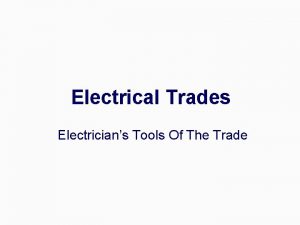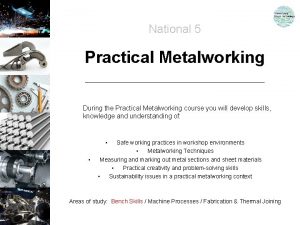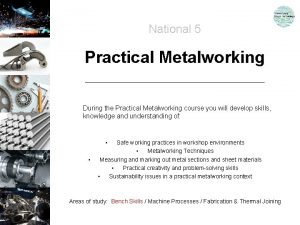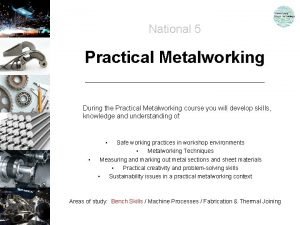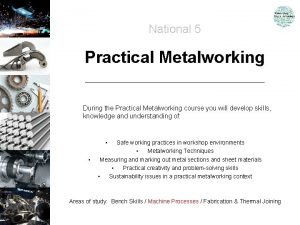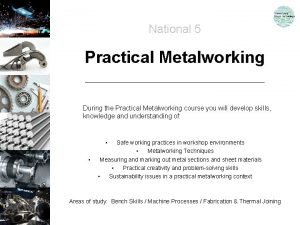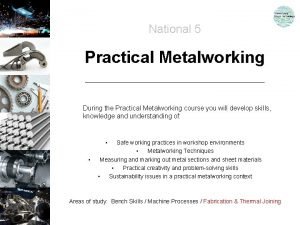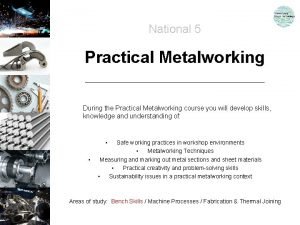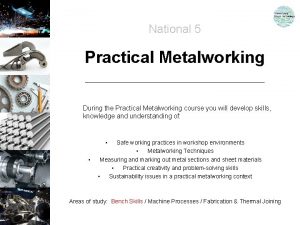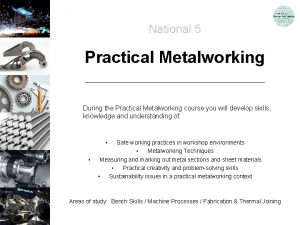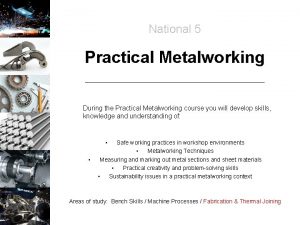National 5 Practical Metalworking During the Practical Metalworking











- Slides: 11

National 5 Practical Metalworking During the Practical Metalworking course you will develop skills, knowledge and understanding of: • • Safe working practices in workshop environments • Metalworking Techniques Measuring and marking out metal sections and sheet materials • Practical creativity and problem-solving skills • Sustainability issues in a practical metalworking context Areas of study: Bench Skills / Machine Processes / Fabrication & Thermal Joining

National 5 Practical Metalworking Unit 2: Machine Processes - Vertical, Horizontal and CNC Milling Safety Rating: (High)

Machine Processes: Milling Vertical Milling Machine A vertical miller is used to shape metals such as mild steel and aluminium. Full size milling machines such as the one shown below are powerful but also very accurate and precise. These machines can be operated manually or be fully automated. When using a vertical miller, the machine should be set to cut away a small amount of metal at a time. The cutter does this while passing over the surface of the metal. High Speed Steel Cutting Tools

Machine Processes: Milling Vertical Milling Machine The vertical traverse hand wheel (handle) is turned in order to raise or lower the knee. This means that the machine vice is also raised or lowered towards or away from the cutting tool. The machine head can be tilted to a variety of angles allowing chamfers to be machined. Normally this is done by slowly loosening a number of bolts and then tilting the machine head to the required angle. Some machines have a gauge on which angles can be read so that it can be set accurately.

Machine Processes: Milling Vertical Milling Machine The feed handle is turned by the machine operator. This moves the table and anything bolted to it (such as a vice) towards the cutting tool. Usually, the ‘feed’ of the machine can be set to automatic so that there is no need to turn the handles manually. Using a guard is very important as this will further ensure safety. When the machine is being operated the guards protect the machine operator by preventing hot cuttings of material flying outwards. The operator should always wear the proper PPE.

Machine Processes: Milling Horizontal Milling Machine The Horizontal Milling Machine is a very robust and sturdy machine. A variety of cutters are available to remove/shape material that is normally held in a strong machine vice. This horizontal miller is used when a vertical miller is less suitable. For instance, if a lot of material has to be removed by the cutters or there is less of a need for accuracy - a horizontal milling machine is chosen.

Machine Processes: Milling Horizontal Milling Machine The cutter can be changed very easily. The arbor bracket is removed by loosening nuts and bolts that hold the arbor firmly in position. The arbor can be slid off the over arm. The spacers are then removed as well as the original cutter. The new cutter is placed in position, spacers slid back onto the arbor and the arbor bracket tightened back in position.

Machine Processes: Milling Horizontal Milling Machine A large range of cutters are available. They are generally made from high speed steel which means they will cut through metals such as mild steel. Some of the profiles of the cutters are shown below. Cylindrical cutters are used to remove a lot of waste material from a surface. More detailed cutters, such as concave cutters, are used to machine a shape onto a surface. When machining with any of these cutters it is important to use coolant as the cutter will heat up as well as the material being machined. The coolant cools the cutters and the material which means that the expensive cutters last longer. It is also necessary to remove material a little at a time. Several slow passes over the material may be needed to manufacture the desired shape.

Machine Processes: Milling Horizontal Milling Machine The safest way to machine a piece of metal using a horizontal miller is to feed the metal into the cutter, against its rotation. This is called upmilling. The metal must be held very firmly in a large machine vice, usually a hide mallet is used to hammer round the handle of the vice to ensure it is extremely tight.

Quiz Questions 10 Record answers in your notes jotter 1. What are the cutting tools for the Miller mostly made from? 2. What are the names given to the hand wheels on the Milling machines? 3. What PPE should be worn when operating a Milling machine? 4. Name one other safety precaution when operating a Milling machine. 5. Name three types of cutter used with a horizontal Miller?

Quiz Questions 10 Record answers in your notes jotter 1. What are the cutting tools for the Miller mostly made from? High Speed Steel 2. What are the names given to the hand wheels on the Milling machines? Cross and Vertical Traverse wheel 3. What PPE should be worn when operating a Milling machine? Goggles / Apron / Toe capped boots 4. Name one other safety precaution when operating a Milling machine. Ensure tight by tapping with mallet 5. Name three types of cutter used with a horizontal Miller? Cylindrical / Concave / Convex
 Metalworking hand tool
Metalworking hand tool Most sheet metalworking operations are performed as
Most sheet metalworking operations are performed as National 5 practical cookery time plan
National 5 practical cookery time plan National 5 practical cookery
National 5 practical cookery Các châu lục và đại dương trên thế giới
Các châu lục và đại dương trên thế giới ưu thế lai là gì
ưu thế lai là gì Tư thế ngồi viết
Tư thế ngồi viết Môn thể thao bắt đầu bằng chữ đua
Môn thể thao bắt đầu bằng chữ đua Hình ảnh bộ gõ cơ thể búng tay
Hình ảnh bộ gõ cơ thể búng tay Cái miệng xinh xinh thế chỉ nói điều hay thôi
Cái miệng xinh xinh thế chỉ nói điều hay thôi Mật thư anh em như thể tay chân
Mật thư anh em như thể tay chân Từ ngữ thể hiện lòng nhân hậu
Từ ngữ thể hiện lòng nhân hậu
